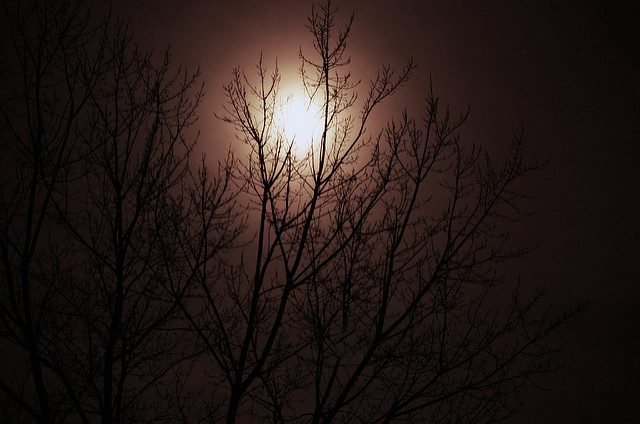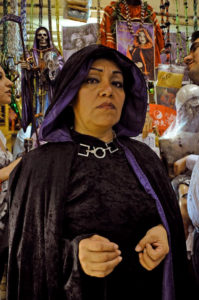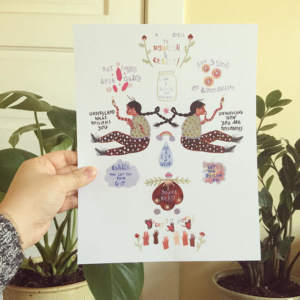
Audrey Lundahl
As we bear witness to a President and sociopolitical culture that poses a threat to marginalized communities, so too do we see the rise of online witchcraft. The digital expression of witchcraft allows many who hold these marginalized identities to find community and combat oppression by practicing magic. Social media is suddenly full of witches, brujas, mystics, astrologers, and those who believe in magic as a practical tool to heal the self and the world. Witches continue to gain popularity online, a space that seems ready-made for the next generation of magic practitioners because of its power to help individuals self-actualize and connect. Online is only one point of connection for witches, though, who see the world, including the digital, as full of connection between bodies, spirits, and the earth.
Community Building Online

Online is a useful tool for witches to build community. Well-known witch and founder of the Reclamation witches in San Francisco, Starhawk, writes, “I see Pagans, especially Witches, as evolving into what I will call the People of the Web.” The Web can be particularly useful for a spiritual practice like witchcraft, which is often met with fear and judgement from outsiders. Starhawk continues, “The anonymity of online communications liberated witchen folks to express their thoughts and feelings and experiences in relative safety. So, in a sense, the Web became our church.” The Web is full of sometimes private forums and digital gatherings of witches who can connect across the world and find common ground with an understanding, nonjudgmental community.
The widespread use of the internet as a tool for connecting also has a positive effect on the representation of the witch community. The image of the witch in popular media, from fairy tales to new age books, is often one-dimensional. As Bri Luna explains on The Witch Wave podcast, “When you think of faeries and witches you think of, like, whimsical white women. As I started really getting in touch with my roots and my culture and getting in touch with my ancestry, that’s where I really saw the magic in these other cultural stories… there are witchy stories from around the world but there’s no representation.” Luna, who identifies as Black and Mexican, uses her connection to her witch roots to push for wider witch representation via her website and accompanying popular Instagram, The Hood Witch. She talks about how she consciously features products from Indigenous communities along the West Coast and Tarot decks created by “other [POC] mystics who have really cool artwork and that mainstream places aren’t selling.”
Community building and representation, then, are connected for the digital witch. Twitter and other social media allows for a wide representation and offers a space for witches outside the mainstream image of “whimsical white women” to come together. Self-identified witch Joanna C. Valenta tweets of her online community building: “Resistance/standing together creates power and support, esp for those who feel other in various communities (queer, POC, etc.).”
Bodies as Connection and Resistance
Although witches are using the internet to connect and share with wider communities, the web is only one aspect of the wider interconnectedness of witchcraft. Bodies also manifest magic for witches. Energy transmutation, a central principle for making magic, involves the energy of the body connecting to the energy of others and the Earth. This theory and practice of energy transmutation is an expression of the overall trend of connection for witches. As Valenta explains in a tweet, “I identify as a witch bc I believe in harnessing energy + vibes + using our bodies to make the world better/find fulfillment.” Witch spirituality then, is about connecting the material and the spiritual and seeing that the two cannot be separated. Luna writes on her Hoodwitch.com blog, “To be a witch is to reclaim the power of connecting with our bodies, our spirit and the earth and in ungovernable ways, to create paths towards a more regenerative, sustainable society through channeling our ancestors and wisdom from other realms.” The spiritual energy that runs through the material body also exists in everything. Such energy or spirit or knowledge from other beings and other realms can manifest itself in the body to shift a witch’s being. Starhawk writes of Goddess rituals: “When I experience the shift in consciousness that transforms me into whatever deity is manifesting in my body, I am ecstatic, in the sense that I am out of my stasis.” This consciousness shift can lead to seeing the world more clearly and working toward social justice. Astrologer Irisha Yardenah tweets, “We come into physical, third dimensional form so we can actualize our purpose. So we can bring Love into manifest.” Physical manifestation has a powerful divine purpose for witches to connect the digital and spiritual to the embodied.
 Since witchcraft uses the body as a point of energy manifestation, self-care is considered an important aspect of Witchcraft as a method of resistance. HoodWitch.com astrologer Jessica Landyadoo connects this self-care to care for others, writing on Twitter, “The world is in a fragile, fertile place & so are you. How u care for yourself & others is your legacy.” This care-work can come via rituals, visualization, spells, or other forms of magic. The Twitter account Olde Ways suggests a visualization: “Visualize yourself surrounded by vibrant orange light for self empowerment and to restore your energy.” Artist and self-identified bruja, Rebecaa Artemesia, sells an artprint via Etsy the image of which has also been shared widely on Pinterest and Instagram that she calls “A Spell to Nourish and Resist.” She instructs via words and illustrations “Put chilled rose quartz and 3 slices of blood orange in a jar of water. Understand what poisons you; understand how you are poisonous. Take a sip of water. Exhale and let the pain go. Let the poison go. You’re ready.” This spell offers a chance for reflection on personal pain and an invitation to be accountable for how you contribute to the pain and oppression of society. Digital sharing allows for contemporary witches to share their message and realize their purpose: to care for others, you must care for yourself; to care for yourself is to care for others.
Since witchcraft uses the body as a point of energy manifestation, self-care is considered an important aspect of Witchcraft as a method of resistance. HoodWitch.com astrologer Jessica Landyadoo connects this self-care to care for others, writing on Twitter, “The world is in a fragile, fertile place & so are you. How u care for yourself & others is your legacy.” This care-work can come via rituals, visualization, spells, or other forms of magic. The Twitter account Olde Ways suggests a visualization: “Visualize yourself surrounded by vibrant orange light for self empowerment and to restore your energy.” Artist and self-identified bruja, Rebecaa Artemesia, sells an artprint via Etsy the image of which has also been shared widely on Pinterest and Instagram that she calls “A Spell to Nourish and Resist.” She instructs via words and illustrations “Put chilled rose quartz and 3 slices of blood orange in a jar of water. Understand what poisons you; understand how you are poisonous. Take a sip of water. Exhale and let the pain go. Let the poison go. You’re ready.” This spell offers a chance for reflection on personal pain and an invitation to be accountable for how you contribute to the pain and oppression of society. Digital sharing allows for contemporary witches to share their message and realize their purpose: to care for others, you must care for yourself; to care for yourself is to care for others.
Faith in the Unknown
Besides particular attention to caring work and community building, the rise of contemporary witchcraft is largely a response to an uncertain sociopolitical state that has made many feel hopeless and/or fearful. Magic, on the other hand, leaves space for hope as well as comfort in the unknown. Olde Ways writes on Twitter, “I have faith in the unseen. I can FEEL it happening.” This sentiment can feel extremely comforting when your very identity could be under attack from those in political power. Finding a wider (online) community to support your belief in the unknown and foster hope together through ritual can feel even more comforting.
A trust and comfort in the material forces can allow a witch to let go of control. Luna writes on her HoodWitch.com blog, “A predominant part of witchcraft is completely based within ‘the unknown.’ We communicate with things we cannot see or are told have no vocabulary. We know how to improvise, to work with flowers and weeds and how to heal ourselves and oftentimes others. The epitome of being a witch is the knowledge of the earth’s force, an awareness of the changing seasons, positions of the stars and the knowledge of our own and other witches’ power.” Magic gives a witch an opportunity to trust the unseen, unexplained power of herself and other communities who also actively resist oppressive forces. Magical resistance offers hope that the knowledge of the Earth and its positive, life-affirming forces will take care of you as long as you work to heal yourself and others.
Dr. Audrey Lundahl is a Visiting Assistant Professor of Multicultural Women’s and Gender Studies at Texas Woman’s University, where she also received her PhD. Her research on Ecofeminist spirituality, has been previously published in the edited collection Mothers and Food (Demeter Press) and will soon be published in The International Review of Social Research. is a Visiting Professor in Multicultural Women and Gender Studies at Texas Woman’s University.
